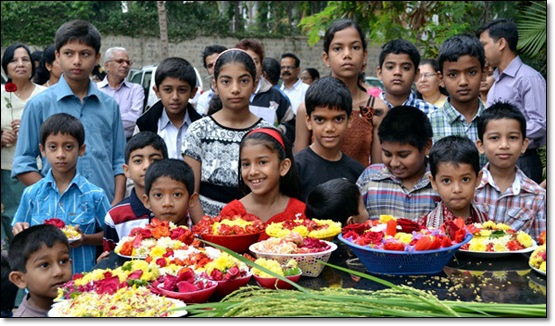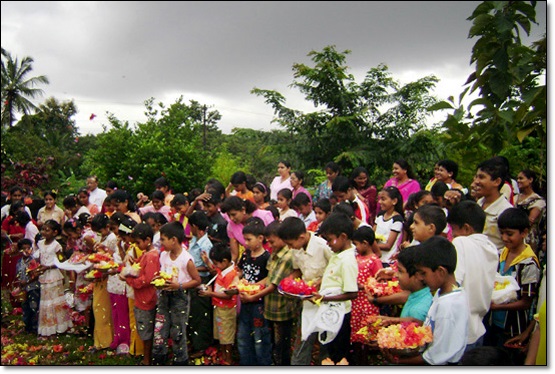

A brief History of the Feast of Nativity of Blessed Virgin Mary - Monti Fest
By Alphonse Mendonsa

Bellevsion Media Network
08 Sep 2013: Today all Konkani Catholic community all over the globe celebrates the Feast of Nativity of Blessed Virgin Mary also known as ’Monthi Festh’ in grandeur. While Mangalore, Karwar and Sindhudurg dioceses celebrate Monthi Festh on September 8, the Konkani Catholic community spread all over the globe select one of the days according to their convenience and celebrate Monthi Festh with lots of cultural activities.
The Feast of Nativity was started by our ancestors in Goa. As we know that our ancestors were Hindus before and they were celebrating various festivals. The feast of new fruit/corn was one of them. They used to celebrate this feast by offering flowers to their God and by bringing new corn home. They also used to have meal with all family members. This festivity was celebrated continuously for nine days.

When the Portuguese established their rule in Goa in 1510, they began to convert the Hindus to Christianity. However, the converted Christians could not part away with their age old customs, traditions, culture and festivals. Under these circumstances, the priests thought of a plan and they combined their important festivals with the feasts of saints and Mother Mary. Therefore, currently what we practice today in our feasts are the age old customs and traditions that can be seen in festivals of our Hindu G.S.B brothers. For example, distribution of new corn/fruits, sugar cane and a few others customs.
In the Shrine of Mount Mary at Bandra, Mumbai, the feast of Nativity of Blessed Virgin Mary (Monthi Festh) has been celebrated from the following Sunday of Monthi Festh and this grand celebration continues for eight days. Originally this Bandra Feast, what they call it now, was started in 1556 by Jesuit Priests. As the church was situated at the Bandra Hill, they christened Mother Mary as “Mount Mary” (means: Mother of Hill). Gradually this church/feast became a pilgrimage and thousands of devotees flock to this holy site. The transport/communication between Bombay-Goa was strong in those days and as such the Goan priests combined this feast with new corn or new fruit of the earth. In Portuguese “Mount” means “ Monthe” and hence, this feast was finally christened in Konkani as “Monthi Saibinnichem Festh” Since the new corn feast was conducted for nine days by our ancestors, nine day Novena to Mother Mary was also introduced along with new corn tradition of the feast. As the new corn feast was an important feast of our ancestors, they began to celebrate the feast of the “Monthi Saibinnichem Festh” or feast of Nativity of Blessed Virgin Mary with traditional gaiety and enthusiasm.

The Konkani community of Kudal and Ratnagirieven today call this feast as “Monthi Saibinnichem Festh” and they too like in other places celebrate by showering flowers, having Novem and also follow the tradition of remembering the ancestors and having a family meal together with Novem or new corn. However, the way Novem is consumed by various Christian communitiesis vary depending on regions. The new corn is consumed through various means such as in Milk, coconut milk, Payasam (Vorn) or even in beaten-sweet-rice. However, there a little difference in celebration of feast among the Konkani community in various regions.The statue used for this feast is the famous Infant Mary’s “Maria Bambina“ and by mistake we call it “Monthi Saibinnichi Imaz” whereas they use the real “ Monti Saibinichi Imaz”, that is the replica of “ Mount Mary “ from Bandra (Mumbai).
So, when did we begin to use statue of Infant Mary for our Monthi Festh? The statue for Monthi Festh which we use,is called “Maria Bambina”. The history of this statue is very interesting.

The statue “Maria Bambina” was modeled in wax in 1735 by Sr. Izabella Chaara Fornari, superior of the Poor Clare Sisters in Italy. This statue was venerated in public only on 8 September and due to this public appearance and devotion many were benefitted and hence globally this statue was christened as “Statue of Miracle”. It was transferred in 1856 to the Mother House of Sisters of Charity in Milan (Italy). This statue is in the possession of Sisters of Charity even today and it has been used for spreading the devotion.
In 1568, Franciscan Fathers built a church in Arkulla (Mangalore) and dedicated it to St. Francis of Assisi. Since the Portuguese were conducting the trade via river in this area, the area was christened as “Firgyanchi Pent” which means “The town of Gora/White” which is today called as “Farangipet” This church was one of the three churches built by the Portuguese in Mangalore.
While Fr. Joachim Miranda was serving in Gangoli in the years 1759-1762,he was transferred to Farangipet in 1763. He started a seminary for the priests and was called it “Monthe Mariano”. He was a well-known and good priest among the laity. He was attracted by statue of “Maria Bombina” made by Sister of Franciscan, Italy. He introduced this statue to the Monthi Festh and the new spirit and enthusiasm was created for celebration.

Hence, this is the only traditional feast which came down from our ancestors and luckily we practice and celebrate as new corn feast giving thanks to Almighty for His abundance blessing and giving us the fruit of the earth to survive.
Let us celebrate this great feast Monthi Festh with devotion and let us spread the love and unity within our families and among all Mangalorean and Goan community all over the world and continue this traditions forever.
Wishing our viewers a Blessed Feast of Nativity or Monthi Festh.